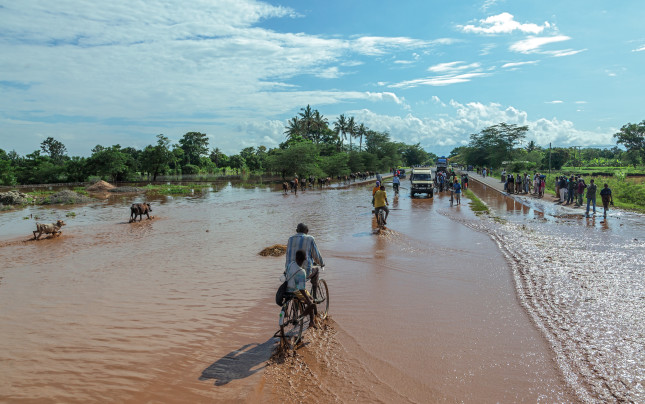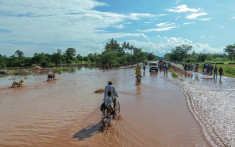-
From Caution to Creative Solutions: The Necessary Evolution of the Climate Migration Debate
November 20, 2019 By Kayly Ober Over the years, experts have cautioned against speaking of “climate refugees.” They argue that the term “refugee,” as defined by the 1951 Refugee Convention, only applies to those who flee across borders out of fear of persecution and violence. Furthermore, evidence shows that migration is a complex phenomenon. While climate change may influence decisions to migrate to some degree, it would likely drive internal movement along well-worn migration routes, often rural-urban in nature. Ultimately, experts have argued that policymakers should think of migration as a form of adaptation to climate change, and reject the term “climate refugee.”
Over the years, experts have cautioned against speaking of “climate refugees.” They argue that the term “refugee,” as defined by the 1951 Refugee Convention, only applies to those who flee across borders out of fear of persecution and violence. Furthermore, evidence shows that migration is a complex phenomenon. While climate change may influence decisions to migrate to some degree, it would likely drive internal movement along well-worn migration routes, often rural-urban in nature. Ultimately, experts have argued that policymakers should think of migration as a form of adaptation to climate change, and reject the term “climate refugee.”
Over the years, experts have cautioned against speaking of “climate refugees.” They argue that the term “refugee,” as defined by the 1951 Refugee Convention, only applies to those who flee across borders out of fear of persecution and violence. Furthermore, evidence shows that migration is a complex phenomenon. While climate change may influence decisions to migrate to some degree, it would likely drive internal movement along well-worn migration routes, often rural-urban in nature. Ultimately, experts have argued that policymakers should think of migration as a form of adaptation to climate change, and reject the term “climate refugee.”
However, François Gemenne, the director of the Hugo Observatory on Environment, Migration, and Politics, believes that we shouldn’t shy away from speaking of “climate refugees.” He argues that while the industrialized North is responsible for carbon emissions, the Global South is left to weather adverse effects, making “climate-induced migration…a very political matter, rather than an environmental one.” In the end, “migration is the mode through which these inequalities materialize.”
While politics is one reason to speak of “climate refugees,” reality is another.
Evidence increasingly shows that climate change is making catastrophic events the new normal. Hurricane Maria in Puerto Rico in 2017 was 30 percent more powerful than any other storm ever recorded on the island – an occurrence which scientists believe that climate change may be making 5 times more likely. This year, Cyclones Kenneth and Idai ravaged Mozambique, the first time two major storms hit the country in the same season. In September, Hurricane Dorian stalled over the Bahamas for more than 24 hours, providing evidence in line with a joint NASA-NOAA study which finds that hurricanes in the North Atlantic have been moving slower and stalling more. Moreover, oceans are warming, glaciers are melting, and sea-level rise is threatening coastlines much faster than previously thought. This means that some islands and low-lying metropolitan cities will likely become “uninhabitable.”
To be clear, speaking of “climate refugees” does not mean expanding the definition under the current 1951 Refugee Convention, which is already under attack. Talk of “climate refugees” should also not be all doom and gloom, which could potentially trigger kneejerk border security policies. It should, however, mean recognizing that climate change may induce movement in ways that we are underestimating and underprepared for.
Once we acknowledge this, creative policy solutions become clearer:
Expanded protection mechanisms. This is perhaps the most pressing policy solution, but also the most contentious. Given that the 1951 Refugee Convention definition of “refugee” will not change anytime soon, a popular form of expanded protection today are humanitarian visas. For example, New Zealand offered special humanitarian visas to climate-affected Pacific Islanders in 2017. This plan was abandoned to focus on Pacific Islanders’ stated priorities instead, which are to invest in emissions mitigation and “migration with dignity,” whereby their citizens will be taught new skills to be able to work in other countries on their own terms. It appears, however, that the appetite for humanitarian visas may still be growing. This year, U.S. Senator Ed Markey introduced a bill to recognize “climate-displaced persons” that would welcome up to 50,000 people in an individual fiscal year to resettle in the United States.
Planned relocation. Given pending catastrophic climate impacts, policymakers need to seriously consider planned relocation. The Pacific Islands have been leading the way. For example, Vanuatu has created a comprehensive policy on climate change and disaster-induced displacement, which includes developing safeguards and standard operating procedures for planned relocation. The plan also outlines the need for technical expertise and financing. With this in mind, Fiji’s Climate Change Relocation and Displaced People’s Trust Fund may be used as a model, as they will raise revenue through an innovative Environment and Adaptation Levy.
Global platforms for action.
- UNFCCC and “task force on displacement” (TfD). In 2015, the TfD was established through the UNFCCC process to provide technical and policy advice on the impacts of climate change on forced displacement and migration. Their input will be essential in determining how displacement figures into discussions of “loss and damage,” including the potential establishment of something like a “climate displacement facility,” where compensation for losing livelihoods or land could be negotiated. The growing accuracy of “attribution science,” where scientists can parse the degree to which climate change influences biophysical impacts, may provide a much-needed new springboard.
- The Global Compact for Safe, Orderly, and Regular Migration (GCM). The GCM is the first global agreement of its kind on migration which explicitly refers to the need to address protection gaps for people displaced by the effects of climate change. It remains to be seen how this will be implemented on the ground, but a mechanism for review, the International Migration Review Forum, has been established and the review process is set to start in 2022.
- The Platform on Disaster Displacement (PDD). This secretariat is a follow up to the Nansen Initiative, which cobbled together a Protection Agenda for people displaced across borders by disasters around existing frameworks and soft laws that states can voluntarily adopt. Their implementation workplan will run through 2022. PDD and other entities see most potential to create protection mechanisms within a regional context. For example, the “Guide to Effective Practices for Regional Conference on Migration Member Countries: Protection for Persons Moving across Borders in the Context of Disasters” in the Americas and the Economic Community of West African States’ Free Movement Protocol have been held up as regional frameworks of promise.
While these policies are varied, they should all aim for the same goal: to give those displaced by climate change greater agency to choose how and when to move on their own terms and with as much protection and equitable remuneration as possible. This fundamental principle should be kept in mind as policymakers step into the room at the Global Refugee Forum and COP25 this year.
Kayly Ober is senior advocate and program manager of the climate displacement program at Refugees International. She previously worked with the Asian Development Bank, Overseas Development Institute, and the World Bank, where she was a lead author of the flagship report Groundswell: Preparing for Internal Climate Migration. She was a program assistant with ESCP from 2009 to 2012.
Sources: Asian Development Bank, Forced Migration Review, Fijian Government, Geoforum, Geophysical Research Letters, German Institute for International and Security Affairs, Intergovernmental Panel on Climate Change, Nature, New York Times, Office of U.S. Senator Ed Markey, Platform on Disaster Displacement, Policy Forum, Politico, Refugees International, Translocal Resilience Project, United Nations High Commissioner for Refugees, United Nations Framework Convention on Climate Change, World Bank
Photo Credit: Photo via Shutterstock. All rights reserved.
 A Publication of the Stimson Center.
A Publication of the Stimson Center.

 Over the years, experts have
Over the years, experts have 

